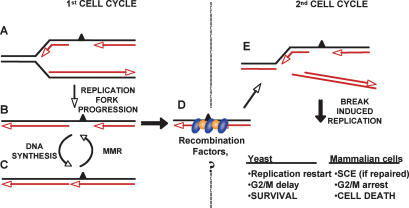Figure 8.
Model for the roles of replication, MMR, and recombination in DNA transactions induced by MeG. (A) When replication forks encounter MeG in the template DNA of MMR-proficient cells, they insert C or T and proceed with replication. The MeG-containing mispair activates MMR, which degrades the newly synthesized strand up to and some distance past the MeG residue. (B,C) This gap cannot be filled in, because MMR repeatedly inhibits post-replicative gap repair. In the presence of functional recombination, the gaps are protected and progress to the next cell cycle (D), where they cause replication fork collapse (E). The collapsed replication forks can be restored with the help of HR, which leads to cell survival, at a cost of higher SCE levels. Cells that fail to rescue the forks arrest in G2/M and subsequently die because of their inability to restart replication.

